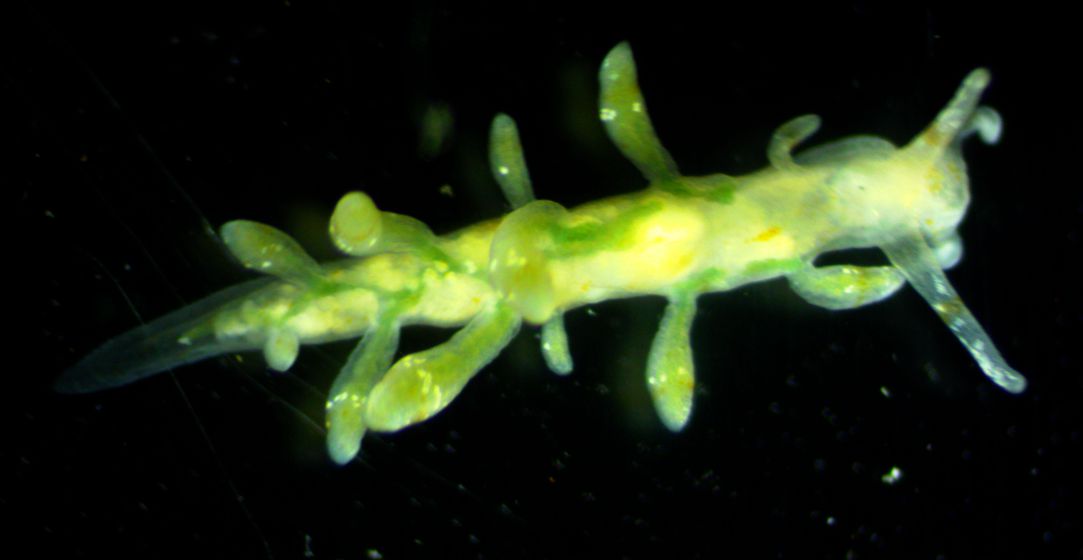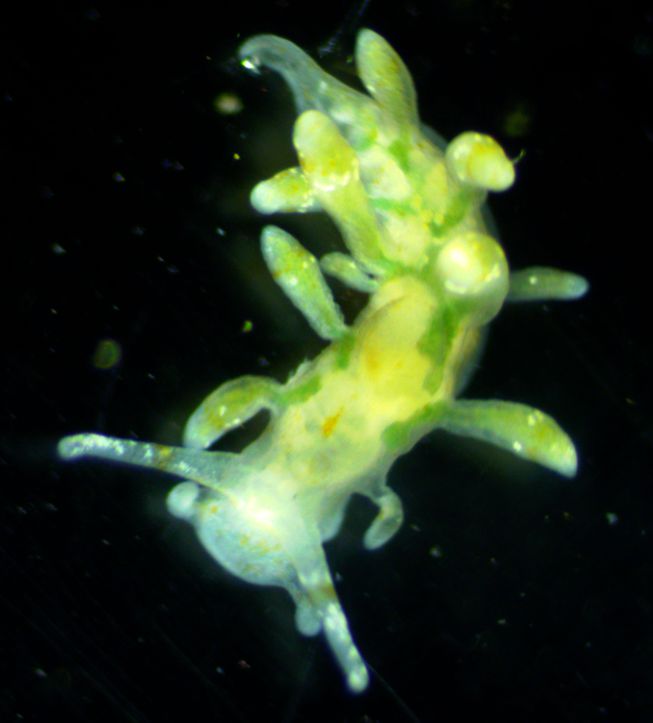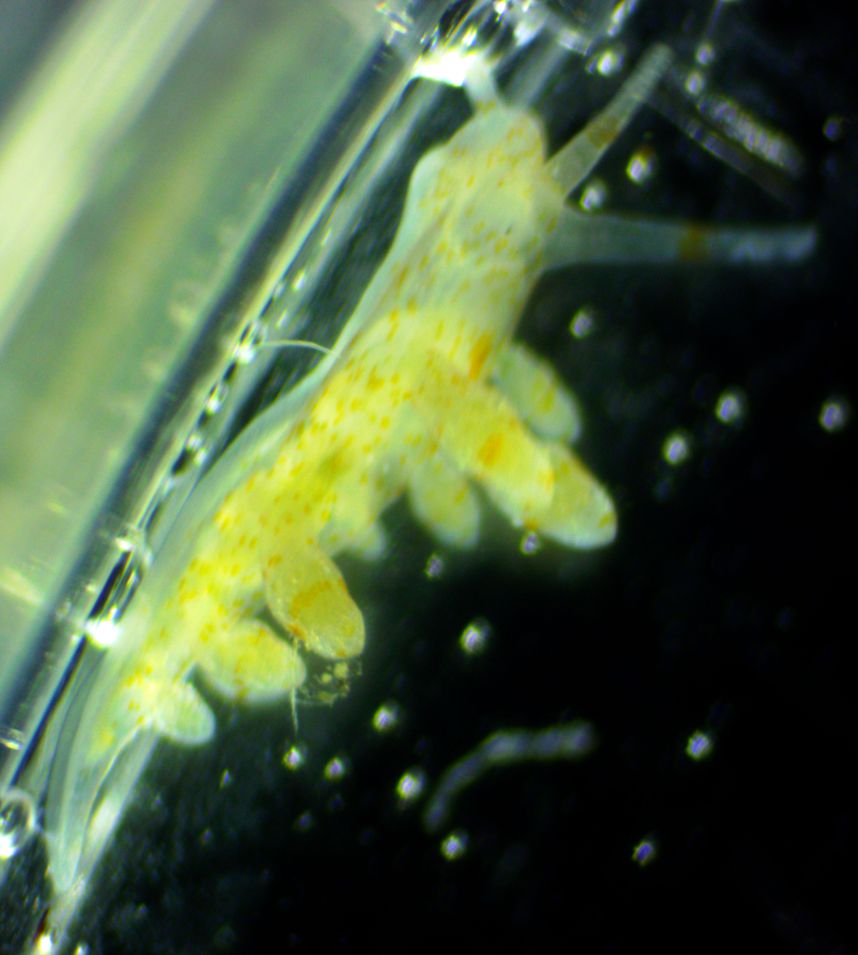Eubranchus rupium (Moller, 1842)Common name(s): Rocky aeolid, green balloon aeolid |
|
| Synonyms: Tergipes rupium, Galvina rupium, Eubranchus olivaceus, Nudibranchus rupium |  |
|
Class Gastropoda
Family Eubranchidae
|
|
| Eubranchus rupium, 5 mm long, found flushed through the Rosario seawater system into a water table. | |
| (Photo by: Dave Cowles, August 2014) | |
Description: This species has prominent dorsal, unbranched cerata (more than two) which do not have any sail-like posterior extensions. The cerata are irregularly inflated (somewhat partly-inflated balloonlike-see photo above), especially near the ends, but not warty, and have white speckles, an olive-green or reddish-brown subterminal band, and an olive-green core. The dorsum is pale yellowish-green, partly translucent, with no opaque median longitudinal white line nor longitudinal olive-green stripes connecting the cerata bases but does have light brown dots and a median, longitudinal band of olive-green. The rhinophores are smooth, speckled with white flecks, and may have a subterminal band of red-brown or olive-green but no orange or red color. Have two fingerlike (digitiform) oral tentacles but no oral veil between them. Up to 6, 9, or 12 mm long according to different references.
How to Distinguish from Similar Species: I at first confused this small individual with a sacoglossan but sacoglossans generally have longitudinally rolled plates for rhinophores and do not have oral tentacles. The related species E. rustyus has no deep olive-green band on the dorsum and has subapical brown, greenish, or light gray bands on the rhinophores and oral tentacles and yellow dots along the sides of the body. Pacific coast individuals of this species were formerly called E. olivaceus.
Geographical Range: Circumpolar, at least in the NE Pacific down at least to Baja California; Sea of Japan, Greenland, eastern Canada and New England, Scandinavia, and the Netherlands. Originally described in Greenland.
Depth Range:
Habitat: Not specified but "rup" in Latin = "rock" and "rupi" = filth. Likely lives on hydroids attached to rocks.
Biology/Natural
History: Feeds
on the hydroids Laomedea
longissima, Obelia
spp., and Plumularia
spp.
by mechanically boring into them and sucking the contents out (Mikhlina
et al., 2020). This species has eggs of 85 micrometers
diameter, is
244 micrometers at hatching, and has planktotrophic development (the
pelagic
larvae feed in the plankton) (Goddard,
2004)
| Return to: | |||
| Main Page | Alphabetic Index | Systematic Index | Glossary |
References:
Dichotomous Keys:Carlton, 2007
General References:
Behrens,
1991 (As E.
olivaceus)
Behrens
and Hermosillo, 2005
Scientific Articles:
Goddard, Jeffrey H.R., 2004. Developmental mode in benthic opisthobranch molluscs from the northeast Pacific Ocean: feeding in a sea of plenty. Canadian Journal of Zoology 82:12 pp 1954-1968.
Mikhlina,
Anna, Irina Ekimova, and Elena Vortsepneva, 2020. Functional
morphology
and post-buccal development of the buccal complex in Eubranchus rupium
(Nidibranchia: Aeolidida: Fionidae). Zoology 143, 125850.
https://doi.org/10.1016/jzool.2020.125850
Web sites:
Seaslug
forum
General Notes and Observations: Locations, abundances, unusual behaviors:
We found the nudibranch photographed on this page in seawater from our seawater system in August, 2014. The animal must have been sucked into the seawater intakes, which are about 1.5 m off the bottom and 5-6 m from the surface, so it may have still been pelagic or perhaps was feeding on hydroids near the intake. The intakes are screened so it must have been taken in when it was even smaller than at present. The animal is very active and mobile--hard to photograph because it moves so fast.

Another view of the same individual as it charges around the
dish.
The green gut, which extends up into the cerata,
can be clearly seen. Length 5 mm. Photo by Dave Cowles, August 2014


My thanks to Karin Fletcher who helped me identify this
species which
does not appear in Kozloff's key.
Authors and Editors
of Page:
Dave Cowles (2022): Created original page
CSS coding for page developed by Jonathan Cowles
Salish Sea Invertebrates web site provided courtesy of Walla
Walla University